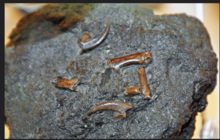Chumash traditional medicine
In the modern day, certain medicinal practices are viewed as controversial, including the treatment of menstruating women, the use of poisonous datura plant, and the consumption of dangerous polycyclic aromatic hydrocarbons.
[3] Both medical philosophies rely on maintaining the balance between two forces; Yin and Yang for the Chinese, a similar Chumash concept being “the Sun and Sky Coyote“.
For example, treatment of diseases caused by excess “cold” would include plant remedies which “warm” the patient, such as those with adrenergic properties that increase heart rate and blood flow.
This principle was behind the Chumash practices of bathing daily in cold water, as well as using sweat lodges and hot springs to harness the healing properties of heat.
argue that Chinese explorers landed in California in the early 15th century, as well as other Pre-Columbian transoceanic contact theories, but the validity of such claims remain in dispute.
[4] In Chumash culture, the most important work of the healer was thought to occur before anyone fell ill by helping foster a balance of tribal values.
As healing was also seen as a communal process, the patient was often joined by family and friends who might offer support by participation in dancing, singing, fasting, and praying.
[5] Gonorrhea afflicted the Chumash people pre-European contact, but cases of the disease increased with the rise of Spanish missions, decreasing fertility.
Seawater as a source of saline and other healing minerals was used to treat sores from venereal diseases, as well as medicinal tea made from carrizo cane.
Thus, when the moderate to heavy drinking found in European frontier communities was introduced to the Chumash and other Native peoples, they were at a much higher risk for abuse.
This high rate of abuse has led to a number of modern methods of alleviation, including non-native ones such as Alcoholics Anonymous (AA) and Native practices involving spiritual and communal efforts to break addiction.
[8] 1769 marked the beginning of Spanish military and religious missions to assimilate Chumash in the Alta region of California, roughly around modern-day Santa Barbara.
Prior to colonization, the Chumash enjoyed ecological abundance and diversity even during cyclical droughts and El Niño events, indicating a millennia-long period of acclimatization to their environment.
However, this narrative has been replaced by a more nuanced perspective consisting of exacerbated environmental fluctuations from overpopulation and over-utilization of natural resources due to Spanish colonization.
The religious conversion of Chumash also corresponds to documented disease increases and poorer health post-colonization recorded by even the early Spanish conquistadors.
[9] Polycyclic aromatic hydrocarbons (PAHs), a chemical product of fossil fuels found in substances such as gasoline, tar, and cigarettes, cause adverse health effects such as neurological disorders, hormonal disruptions, and fetal abnormalities.
Thus, the Chumash have been a target of interest for research on PAH exposure, owing to their prolific use of PAH-containing bitumen over the previous millennia (with evidence of use in objects as far back as 10,000 years ago).
Chumash expert Patricia Lambert of Utah State University has questioned this hypothesis, citing the need for increased research on the controversial topic.
It is also hypothesized that a number of plants consumed by the Chumash may have alleviated the harmful effects of PAH exposure, leading to modern theories about botanical and nutritive cancer-prevention substances.
Deaths from datura in Chumash communities were often seen as the fault of the drinker, who was assumed to have deviated from the necessary dietary or sexual restrictions, or have chosen to not come back from the experience.

